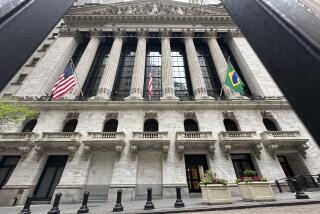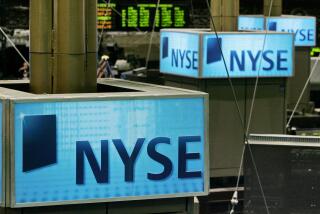Can Profit Data Match Investor Hopes?
- Share via
As quarterly earnings-reporting seasons go, this one is likely to get more than the usual attention on Wall Street.
The focus on the honesty of corporate accounting in the aftermath of Enron Corp. and its ilk should put a premium on greater disclosure in first-quarter reports, which will begin to dominate the business headlines starting the week of April 8.
But the key concern of investors, as always, will be the hard numbers on sales and earnings, and what company managements say about business prospects for the next quarter or two.
A big issue is whether many investors have unrealistic expectations for first-quarter profits, given the barrage of upbeat economic data over the last two months.
The stock market’s rally of the fourth quarter, and its ability to largely hold on to or extend the gains in the first quarter, was based in large part on trust that an earnings turnaround is in the offing. Earnings, after all, are what underpin share prices.
The government’s reports on the economy have been almost consistently positive, helping to support stock prices. Friday brought more of the same: The Commerce Department said consumer spending jumped a solid 0.6% in February after rising 0.5% in January.
The strength in consumer spending has belied expectations that Americans would close their wallets in the first quarter to conserve cash in case the economy sputtered again.
But consumer spending also was surprisingly robust in the fourth quarter. That couldn’t halt another devastating decline in corporate earnings in the period: Operating profit of the blue-chip Standard & Poor’s 500-index companies slumped 21.7% in the fourth quarter from a year earlier, according to earnings-tracker Thomson Financial/First Call in Boston.
The fourth-quarter percentage decline was about equal to the year-over-year profit slide in the third quarter, when the recession was at its worst.
Yet the government reported Thursday that real gross domestic product grew at a 1.7% annualized rate in the fourth quarter, the fastest pace in a year.
“Better-than-anticipated news on consumer spending has yet to give rise to better-than-expected corporate earnings,” noted John Lonski, economist at Moody’s Investors Service in New York.
In the fourth quarter, that was true in part because many companies continued to keep a lid on production and new orders, preferring to let inventories run down to extremely low levels.
In other words, consumers had much more confidence about the future than did many businesses.
In the first quarter, however, production appears to have increased in many business sectors. A report Thursday showed that an index of manufacturing activity in the Chicago area rose more than expected in March. As production rebounds, it boosts many other sectors of the economy--from raw materials to shipping to utilities.
The turnaround in manufacturing, continued healthy spending in the services sector of the economy and the benefits of deep corporate cost-cutting over the last year are expected to lead to a significant improvement in earnings in the first quarter.
But “improvement” truly is a relative term in this case: Many companies still will report sales and earnings that are down from a year earlier. The declines just won’t be as steep as what investors saw in the second half of last year:
* S&P; 500 company sales, in total, are expected to be down 0.4% in the first quarter from a year earlier, according to Wall Street analysts’ estimates as tracked by Thomson Financial/First Call. That compares with a 4% year-over-year slide in sales in the fourth quarter.
* Analysts’ estimates of S&P; 500 operating earnings (profit excluding those ubiquitous “one-time” gains and losses) call for an overall decline of about 9% in the first quarter compared with a year earlier.
If the estimates are on target, the drop in earnings will be half what it was in the fourth quarter--the first sign of a recovery in the corporate bottom line.
Pace of Warnings on Earnings Slows
There may be more reason to be optimistic that first-quarter earnings will be in the expected range, or perhaps even better than expected: Fewer companies have warned in recent weeks that their results will fall short of estimates.
As of last week, 385 companies in Thomson Financial/First Call’s total universe of firms had warned that first-quarter earnings would be below expectations.
By contrast, more than 600 companies had issued warnings by this point in the year-earlier period.
The pace of warnings also is about 27% below what it was at this point in the fourth quarter, said Chuck Hill, research chief at Thomson Financial/First Call.
But the big post-recession improvement in corporate earnings is expected to start in the second quarter and balloon in the third and fourth quarters. That’s why the outlook companies give in their first-quarter profit reports may be more important than their numbers.
“Investors will be looking for any kind of information that sheds light on what the [rest of the year] will look like,” Hill said.
Based on analysts’ current estimates, S&P; 500 operating earnings are expected to rise about 9% in the second quarter from a year earlier. That would be the first year-over-year growth in profit in five quarters.
Hill notes that part of the rebound will stem from an accounting rule change: Many companies no longer will have to amortize (write off) a balance-sheet item known as goodwill, which is the excess an acquiring company pays for another in a merger, above the market value of the target’s assets. No write-off now is required unless the acquired company’s business has plunged in value.
The net effect will be to boost reported earnings at many firms--though companies should be clear in disclosing that benefit, which merely amounts to an accounting entry, not a cash benefit.
Overall, the technology sector is expected to lead the second-quarter profit rebound, with earnings up 38%, on average, from a year earlier. Consumer-goods sectors and financial services also are expected to be particularly strong.
In the third quarter, overall S&P; 500 earnings are expected to rise 30% from a year earlier, according to Thomson Financial/First Call.
But Hill and other analysts are concerned about the trends behind the expected earnings turnaround in the first half of this year.
In the near term, Hill said, “I see the gain [in earnings] mainly due to inventory-rebuilding. But what really counts is, what is final demand doing?”
If inventories are rebuilt, but consumer spending then slows and business capital spending fails to ramp up, the earnings rebound could run out of gas, Hill said.
On the consumer side, one potential source of weakness is the housing market, the strength of which over the last year has been a key element in minimizing the recession.
“The good news is that housing did not go down [last year], so it muted the recession,” said economist Don Straszheim at Straszheim Global Advisors in Westwood. “The bad news is that housing did not go down, so no bounce-back is coming” as the rest of the economy revives.
Instead, as mortgage rates continue to rise with other long-term interest rates, the housing market is poised to decline, albeit gently, Straszheim predicted.
Rising energy prices also are a threat to consumer spending and to corporate earnings. Crude oil prices in New York reached a six-month high of $26.31 a barrel on Thursday--and that was before the military conflict between the Israelis and Palestinians worsened, raising new concerns that Mideast oil supplies could be threatened by a broader conflict.
Earnings Growth Tied to New Capital Spending
On the business side, the biggest question is when capital spending on technology and other equipment will revive. Many economists believe businesses will be slow to order new technology or to commit to expansion projects, considering the unused capacity in many industry sectors.
But there’s a which-comes-first debate (a la the chicken or the egg) involved in the capital-spending question.
If corporate earnings rebound more sharply than expected, many companies could be inclined to use that windfall to invest in new, more efficient equipment, said David Greenlaw, economist at Morgan Stanley & Co. in New York.
Yet the conventional wisdom is that a meaningful profit turnaround can’t occur in many industry sectors until capital spending revives.
Investors will be trying to sort all of this out in the next few weeks, as first-quarter earnings reports arrive.
While estimates of industry sector profit changes may be useful as an overview, what matters, ultimately, is what happens at the individual-company level. Decisions will be made about keeping a stock or dumping it based on what a company reports and the outlook it gives--not on how its sector may perform.
Hill suggests that investors keep one thing in mind when weighing earnings estimates and companies’ turnaround potential: “It was a very different recession, and that suggests the recovery will be different, too.”
That could be for the better, or worse, depending on the industry and on the individual company.
*
Tom Petruno can be reached at tom.petruno@latimes.com. For recent columns on the Web go to: www.latimes.com/petruno.
More to Read
Inside the business of entertainment
The Wide Shot brings you news, analysis and insights on everything from streaming wars to production — and what it all means for the future.
You may occasionally receive promotional content from the Los Angeles Times.










